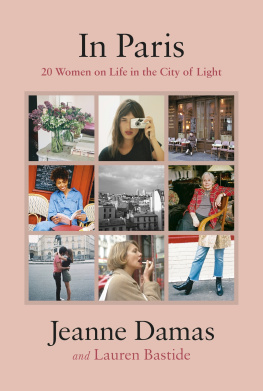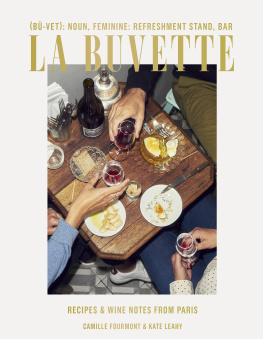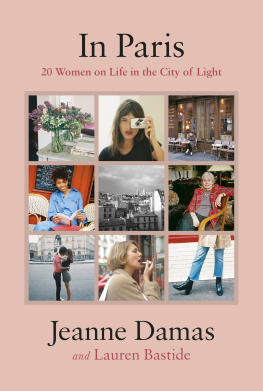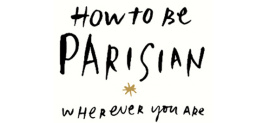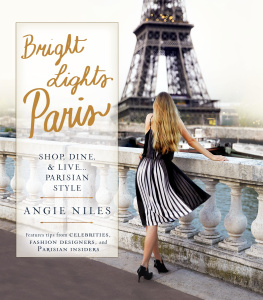Jeanne Damas
and Lauren Bastide
IN PARIS
20 Women on Life in the City of Light

PENGUIN BOOKS
An imprint of Penguin Random House LLC
375 Hudson Street
New York, New York 10014
penguinrandomhouse.com
Published simultaneously in Great Britain by Viking, an imprint of Penguin Random House UK, and in the United States of America by Penguin Books, an imprint of Penguin Random House LLC, 2018
Copyright 2017 by ditions Grasset et Fasquelle
Translation copyright 2018 by Georgina Collins
Penguin supports copyright. Copyright fuels creativity, encourages diverse voices, promotes free speech, and creates a vibrant culture. Thank you for buying an authorized edition of this book and for complying with copyright laws by not reproducing, scanning, or distributing any part of it in any form without permission. You are supporting writers and allowing Penguin to continue to publish books for every reader.
Originally published in French as Paris by ditions Grasset et Fasquelle, Paris
Published by special arrangement with ditions Grasset & Fasquelle in conjunction with its duly appointed agent, 2 Seas Literary Agency.
Library of Congress Cataloging-in-Publication Data
Names: Damas, Jeanne, author. | Bastide, Lauren, author.
Title: In Paris : twenty women, on life in the City of Light / Jeanne Damas, Lauren Bastide.
Other titles: Paris. English
Description: New York City : Penguin Books, 2018. | Translation of: Paris.
Identifiers: LCCN 2018012986 (print) | LCCN 2018038222 (ebook) | ISBN 9780525505471 (ebook) | ISBN 9780143133681 | ISBN 9780143133681 (hardcover)
Subjects: LCSH: WomenFranceParisBiography. | WomenFranceParisSocial life and customs. | Paris (France) Biography. | Paris (France) Social life and customs. | LCGFT: Biographies.
Classification: LCC HQ1620.P2 (ebook) | LCC HQ1620.P2 D36 2018 (print) | DDC 305.40944/361dc23
LC record available at https://lccn.loc.gov/2018012986
Version_1
To our city,
with love.
Foreword
The idea for this book first came about in April 2016. We had this dream of travelling all over Paris to meet the citys most inspiring ladies. Ella Fitzgerald and Louis Armstrong sang about April in Paris, and the city was just like the song: there were chestnut trees in blossom, a sparkling River Seine and Parisiennes shivering in their soft, light knitwear, handbags brimming over beneath tables at caf Aux Deux Amis on rue Oberkampf. It was a typical spring in Paris. But then again, it was unlike any that had come before. The capital was still in shock. Six months earlier, in November 2015, our city had been devastated by gunshots exploding in places where Parisians dance and celebrate. Many young and carefree lives were destroyed. Parisians had spent the winter doing what they do best: drinking, chatting, loving each other, but with underlying anxiety, often glancing over their shoulders. Everyone grieved in their own way, and Paris began to wake up again, cheerfully; bruised, but proud. You could feel all of that outside caf Aux Deux Amis that day.
After our initial meeting, we began our tour of Paris. Between April and December 2016, we roamed the city, but we felt strange. Not sad or bitter. Quite the opposite. Joyful. We wanted to hug people sitting outside bars and restaurants, kiss fellow travellers on the mtro. Weve always been crazy in love with this city, but even more so now, after the tragic events of November 2015. We love its arrogance, its clumsiness, its simplicity. And especially the women who live here after all, according to Jack Kerouac, Paris is a woman!
Anyway, lets go back to the table outside the very Parisian caf Aux Deux Amis, where we sat smoking cigarettes over a glass of Pouilly-Fum. Both of us were ridiculously faithful to the Parisienne stereotype, the woman who has mastered the art of creating an outfit from next to nothing: combining ripped jeans with a cashmere sweater, knotting a trench coat over a floaty dress, rolling up the sleeves of her blazer, slipping on worn-out ballet pumps to go dancing. All the characteristics contributing to the allure of the mythical Parisienne have already been largely, sometimes perfectly, depicted. Others before us have explored the Parisiennes charming moodiness, her confidence and her quirks: the way she raises her middle finger at a driver beeping his horn at her refusal to use the zebra crossing and how she ignores a phone call shes been expecting for fifteen months. In short, her indifference.
We often have fun spotting some of the characteristics of this contemporary heroine in ourselves. But we also often say that the Parisienne is not the idealized woman thats sometimes portrayed. Shes not just this girl with a great look and crazy intensity. Parisiennes are more than that. Because, as we said to each other that day, we know many kinds of Parisiennes. A Parisienne will create her own start-up in Aubervilliers, raise three children near place de la Bastille, thrust her fist in the air as she protests in place de la Rpublique, dance to hip-hop near place dItalie, collect trinkets in Belleville, open a restaurant on rue de Paradis, direct films near Jardin du Luxembourg. We have never met a single stereotypical Parisienne who lives with her cat on boulevard Saint-Germain and spends the day lounging around on a sofa while browsing a collection of short stories by Simone de Beauvoir. Its not that we want to set the record straight or even deny the existence of this archetypal Parisienne. The Parisienne exists, and we know she does because weve met her twenty times for this book. But if theres one thing that defines the Parisienne, a common denominator that goes beyond the way she dresses or speaks, it has to be, first and foremost, her approach to living in the city.
This book was born of a desire to go out and meet authentic Parisiennes from different backgrounds and walks of life. We wanted to discover their many different qualities and create an impressionist portrait of the Parisian woman. We had no intention of shattering the aforementioned stereotype, but instead we wanted to bring the myth to life by interviewing twenty women on the way they choose to live in Paris and their relationship with the city.
Jeanne was born and raised in the eleventh arrondissement, and still lives there in a top-floor apartment overlooking square Maurice Gardette. She describes herself first and foremost as the daughter of a locally renowned restaurateur who ran the fabulous Le Square Trousseau restaurant. She lugs her shopping basket around Aligre market every Saturday and on Sunday shell hunt for pre-loved ceramic vases which shell use to haphazardly display armfuls of wild flowers. Im Lauren, the one writing these words, and Ive just celebrated twelve years in the ninth arrondissement. I push a state-of-the-art buggy down rue des Martyrs, buy tons of left-wing papers and magazines at the weekend and eat organic salads in health-food cafs. If theres something that makes us Parisiennes, its primarily this: the way we construct our daily life in the city. This was the idea that emerged one evening in April at caf Aux Deux Amis, and we decided to put it into practice in the most Parisian of ways: by roaming all over the city.
So, notebook in hand and Olympus camera over the shoulder, we set off to meet our Parisiennes. We chose our interviewees intuitively, with no ulterior motive. We stumbled upon one while scrolling through Instagram, fell in love with another when having a drink one evening in a bar. We consulted friends of friends, mothers of friends, grandmothers of friends, women we admire.

